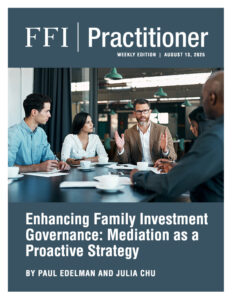
View this edition in our enhanced digital edition format with supporting visual insight and information.
Thanks to Paul Edelman and Julia Chu from the Mediation Virtual Study Group for this article describing how mediation, in addition to being a tool for resolving conflict in family enterprise, can also be used as a proactive governance strategy, particularly in the context of long-term investment decision-making.
Included in the article are examples and strategies that demonstrate how engaging a professional mediator can help families clarify purpose, define roles, and foster cross-generational engagement before tensions arise.
Introduction
Families in business—and those with family offices—often accumulate significant pools of capital through retained earnings, liquidity events, or planned generational transitions. Managing these assets effectively requires not only sound investment strategy but also governance processes that reflect the family’s shared purpose, risk tolerance, and approach to decision-making. Yet, achieving alignment on these matters is often challenging.
When families struggle to align on investment goals or governance processes, the consequences often extend beyond financial performance. Miscommunication and unresolved tensions can erode trust, strain relationships, and ultimately destabilize the enterprise itself. Addressed early, however, these dynamics can be transformed—turning investment management into an opportunity to foster collaboration and reinforce shared purpose.
Here is an example: following a successful business exit, a founder allocated the after-tax proceeds to a long-term investment pool, assuming he would continue guiding decisions as he had during his decades of operating the business. His adult children—now engaged in both the enterprise and the family’s broader planning—had other perspectives. The eldest emphasized capital preservation, the middle child advocated for private equity exposure, and the youngest championed environmental and social impact. What began as a strategic discussion evolved into a deeper negotiation about voice, governance, and generational leadership.
This example highlights a common reality: investment decisions in family enterprises often surface deeper questions of inclusion, legacy, and control. Left unexamined, these dynamics can lead to impasse or conflict, undermining both financial and relational goals.
The Family Investment Context
Family enterprises often reach a stage where operating capital is no longer the only financial focus. Liquidity events, dividends, and deliberate reinvestment strategies frequently result in the creation of shared investment pools—capital earmarked for preservation, growth, philanthropy, or future generational needs.
Unlike institutional investors, families often lack clearly defined processes for how investment decisions are made, who participates, and what principles guide capital allocation. Founders may assume ongoing authority, even as adult children push for a more inclusive or values-driven approach. Siblings may disagree on return expectations, time horizons, or risk appetite. Rising-generation members are often eager to contribute but may lack the knowledge, access, or credibility to participate fully.
What distinguishes the family investment context is not simply the range of financial goals—it is the need to integrate those goals with diverse personal histories, roles, and relationships. Decision-making in this environment is rarely just about performance; it also reflects questions of identity, inclusion, stewardship, and trust.
These realities underscore the need for processes that accommodate both financial rigor and relational sensitivity. Left unstructured, investment decisions can become sites of recurring tension or disengagement. When thoughtfully facilitated, however, they offer an opportunity to strengthen shared purpose, clarify roles, and build a more resilient governance culture.
Mediation as a Proactive Tool for Family Decision-Making
Family enterprises take a variety of approaches to decision-making. Some rely on informal norms or longstanding precedent, while others become entangled in litigation—an adversarial process that often strains relationships and undermines long-term enterprise goals.
Mediation offers a flexible yet underutilized alternative. While traditionally seen as a tool for resolving conflict after it escalates, it can also serve as a proactive strategy for supporting decision-making before breakdowns occur. When introduced early, mediation helps families navigate difficult conversations in ways that preserve relationships and clarify intent.
Mediation often draws on elements of coaching and facilitation, but its core strength is relational. It is particularly useful when trust is strained, stakes are high, or the path forward is unclear. Unlike litigation or arbitration, mediation does not impose a solution; instead, it enables families to co-create agreements that reflect both practical needs and relational values.
Importantly, mediation can help shift conversations from positional bargaining to interest-based dialogue. For families navigating high-stakes decisions, such as how to govern a shared investment portfolio, this move can mark the difference between short-term compromise and long-term cohesion.
Elements of Proactive Mediation for Collaborative Decision-Making
Used proactively, mediation is a practical tool for fostering alignment and supporting sound family decision-making. More than a response to conflict, it supports families in approaching complex conversations with shared intent. When considering bringing in a mediator, advisors should review the following benefits of proactive mediation.
- Bridging Generational Perspectives: Mediation transforms generational differences into opportunities for mutual learning and shared understanding.
- Clarifying Complex Topics: Mediators translate technical or financial language into values-based dialogue, ensuring all voices are informed and included.
- Creating Room for Open Dialogue: Mediation provides a neutral forum where participants can express concerns, articulate hopes, and listen to one another without fear of judgment.
- Encouraging Accountability Without Escalation: Mediation helps clarify roles, set expectations, and address disappointments in ways that avoid blame or disengagement.
- Reducing the Risk of Breakdown or Litigation: By addressing difficult conversations early, mediation helps preserve trust and avoid legal disputes.
Expectations for Advisors and Their Clients When Engaging a Mediator
Mediation is most effective when families approach it with both preparation and purpose. The strategies below can help guide thoughtful, inclusive investment decisions and ensure the process strengthens both outcomes and relationships:
- Establish Clear Objectives: Before entering mediation, families should identify the key outcomes they hope to achieve—such as defining the purpose of shared capital, creating an Investment Policy Statement (IPS), clarifying governance roles, e.g., who approves strategic vs. tactical decisions, or resolving disagreements around investment priorities. It is equally important to name the outcomes they want to avoid. Doing so helps guide the process toward constructive, values-aligned decisions.
- Use Pre-Mediation Surveys and/or Interviews: Anonymous surveys and confidential interviews can help surface individual concerns and priorities, allowing the mediator to structure discussions more effectively. In some cases, interviews may yield valuable insight and help participants prepare for open dialogue. However, when the goal is to foster transparency and shared decision-making, mediators should be cautious not to become custodians of confidential information that undermines group transparency. Establishing clear expectations about the purpose and limits of confidentiality is critical to maintaining neutrality and trust.
- Focus on Shared Values: Mediators can help families surface the values that unite them—such as stewardship, legacy, or impact—and use those shared principles as a foundation for decision-making. Anchoring discussions in values can reduce polarization and strengthen long-term alignment.
- Incorporate Financial Education: For rising-generation members, mediation can include targeted education on investment principles and governance frameworks. Ensuring all participants are confident and informed supports both engagement and equity in the decision-making process.
- Define Next Steps: Every mediation should conclude with clear agreements, action steps, and timelines. Documenting outcomes and responsibilities helps ensure follow-through and accountability—both essential to sustaining trust after the conversation ends.
Conclusion
Investment management within a family enterprise is never just about returns; it is about stewarding shared capital in a way that honors both financial priorities and family relationships. When decisions are misaligned, the consequences can reach far beyond portfolio performance, eroding trust, weakening governance, and putting the family’s legacy at risk.
Mediation offers a powerful way to navigate this complexity. It fosters the clarity and cohesion families in business need to make investment decisions that reflect their goals and strengthen the relationships that sustain the family.
About the Contributors

Paul Edelman, PhD, is an executive coach and facilitator specializing in governance, decision-making, and leadership development in ultra-high-net-worth families and family enterprises. He advises family offices and boards on strategy, collaboration, and rising-generation engagement. He can be reached at paul@edelmancoaching.com.

Julia Chu, CFBA/CFWA, is head of philanthropy & family governance advisory at Neuberger Berman. She develops family governance practices, facilitating legal and practical wealth transitions by aligning family values with trust structures, conducting family meetings, clarifying vision, documenting intent, and guiding succession planning. She can be reached at Julia.Chu@nb.com.

View this edition in our enhanced digital edition format with supporting visual insight and information.





